2014 MERCEDES-BENZ CLS COUPE belt
[x] Cancel search: beltPage 46 of 417

See "Children in the vehicle" for further infor-
mation on children travelling in the vehicle as
well as on child restraint systems
(Y page 55). Important safety notes
G
WARNING
If the restraint system is modified, it may no
longer work as intended. The restraint system
may then not perform its intended protective function by failing in an accident or triggering
unexpectedly, for example. There is an
increased risk of injury, possibly even fatal.
Never modify parts of the restraint system. Do not attempt to modify the wiring as well as
electronic components or their software.
If it is necessary to modify an airbag system to
accommodate a person with disabilities, con- tact an authorised Mercedes-Benz Centre. Restraint system warning lamp
The operation of the restraint system is
checked when the ignition is switched on and at regular intervals while the engine is run-
ning. This allows malfunctions to be quickly
identified.
The 6 restraint system warning lamp in
the instrument cluster lights up when the igni-
tion is switched on. It goes out no later than a few seconds after the engine is started. The
various components of the restraint system
are in operational readiness.
A malfunction has occurred if the 6
restraint system warning lamp:
R does not light up when the ignition is
switched on
R does not go out after a few seconds while
the engine is running
R lights up again while the engine is running G
WARNING
If the restraint system is malfunctioning,
restraint system components may be trig-
gered unintentionally or might not be trig-
gered at all in the event of an accident with a high rate of vehicle deceleration. This can
effect belt tensioners or airbags, for example. There is an increased risk of serious or even
fatal injuries.
Have the restraint system checked and
repaired immediately at a qualified specialist
workshop. PASSENGER AIR BAG OFF indicator
lamp
PASSENGER AIR BAG OFF indicator lamp
:
is part of the automatic child seat recognition
on the front-passenger seat.
A permanently lit PASSENGER AIR BAG OFF
indicator lamp informs you that the front-
passenger front airbag is disabled.
Depending on the person in the front-
passenger seat, the front-passenger front air-
bag must either be disabled or enabled. You
must make sure of this both before and during a journey.
R Children in a child restraint system:
whether the front-passenger front airbag is
enabled or disabled depends on the instal-led child restraint system, and the age and size of the child. Therefore, always observe
the information on "Children in the vehicle" (Y page 55). There you will also find
instructions on backwards and forwards- Occupant safety
43Safety Z
Page 47 of 417
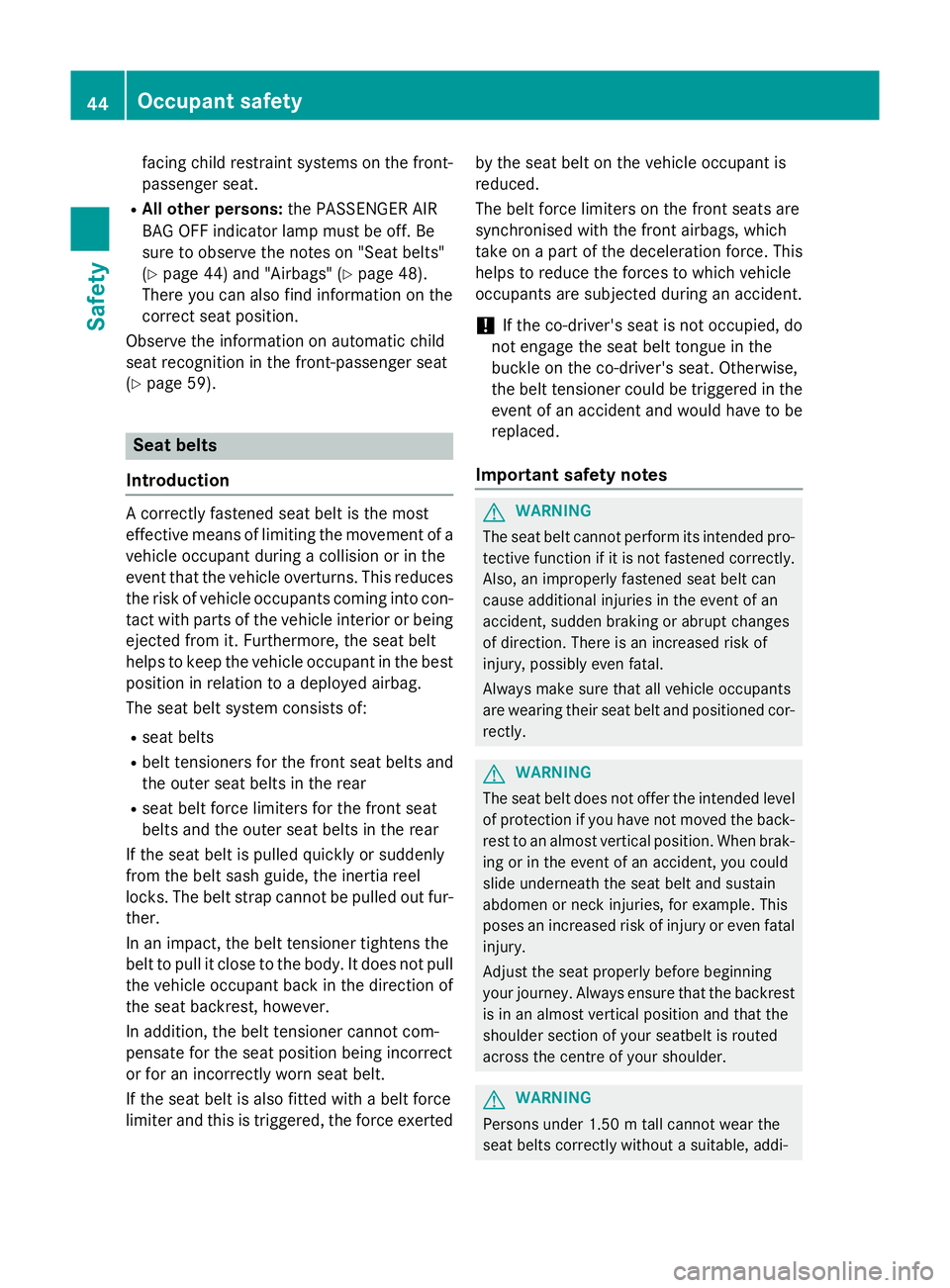
facing child restraint systems on the front-
passenger seat.
R All other persons: the PASSENGER AIR
BAG OFF indicator lamp must be off. Be
sure to observe the notes on "Seat belts"
(Y page 44) and "Airbags" (Y page 48).
There you can also find information on the
correct seat position.
Observe the information on automatic child
seat recognition in the front-passenger seat
(Y page 59). Seat belts
Introduction A correctly fastened seat belt is the most
effective means of limiting the movement of a
vehicle occupant during a collision or in the
event that the vehicle overturns. This reduces
the risk of vehicle occupants coming into con- tact with parts of the vehicle interior or being
ejected from it. Furthermore, the seat belt
helps to keep the vehicle occupant in the best position in relation to a deployed airbag.
The seat belt system consists of:
R seat belts
R belt tensioners for the front seat belts and
the outer seat belts in the rear
R seat belt force limiters for the front seat
belts and the outer seat belts in the rear
If the seat belt is pulled quickly or suddenly
from the belt sash guide, the inertia reel
locks. The belt strap cannot be pulled out fur- ther.
In an impact, the belt tensioner tightens the
belt to pull it close to the body. It does not pullthe vehicle occupant back in the direction of
the seat backrest, however.
In addition, the belt tensioner cannot com-
pensate for the seat position being incorrect
or for an incorrectly worn seat belt.
If the seat belt is also fitted with a belt force
limiter and this is triggered, the force exerted by the seat belt on the vehicle occupant is
reduced.
The belt force limiters on the front seats are
synchronised with the front airbags, which
take on a part of the deceleration force. This
helps to reduce the forces to which vehicle
occupants are subjected during an accident.
! If the co-driver's seat is not occupied, do
not engage the seat belt tongue in the
buckle on the co-driver's seat. Otherwise,
the belt tensioner could be triggered in the
event of an accident and would have to be
replaced.
Important safety notes G
WARNING
The seat belt cannot perform its intended pro- tective function if it is not fastened correctly. Also, an improperly fastened seat belt can
cause additional injuries in the event of an
accident, sudden braking or abrupt changes
of direction. There is an increased risk of
injury, possibly even fatal.
Always make sure that all vehicle occupants
are wearing their seat belt and positioned cor-
rectly. G
WARNING
The seat belt does not offer the intended level of protection if you have not moved the back-
rest to an almost vertical position. When brak-
ing or in the event of an accident, you could
slide underneath the seat belt and sustain
abdomen or neck injuries, for example. This
poses an increased risk of injury or even fatal injury.
Adjust the seat properly before beginning
your journey. Always ensure that the backrest
is in an almost vertical position and that the
shoulder section of your seatbelt is routed
across the centre of your shoulder. G
WARNING
Persons under 1.50 mtall cannot wear the
seat belts correctly without a suitable, addi- 44
Occupant safetySafety
Page 48 of 417
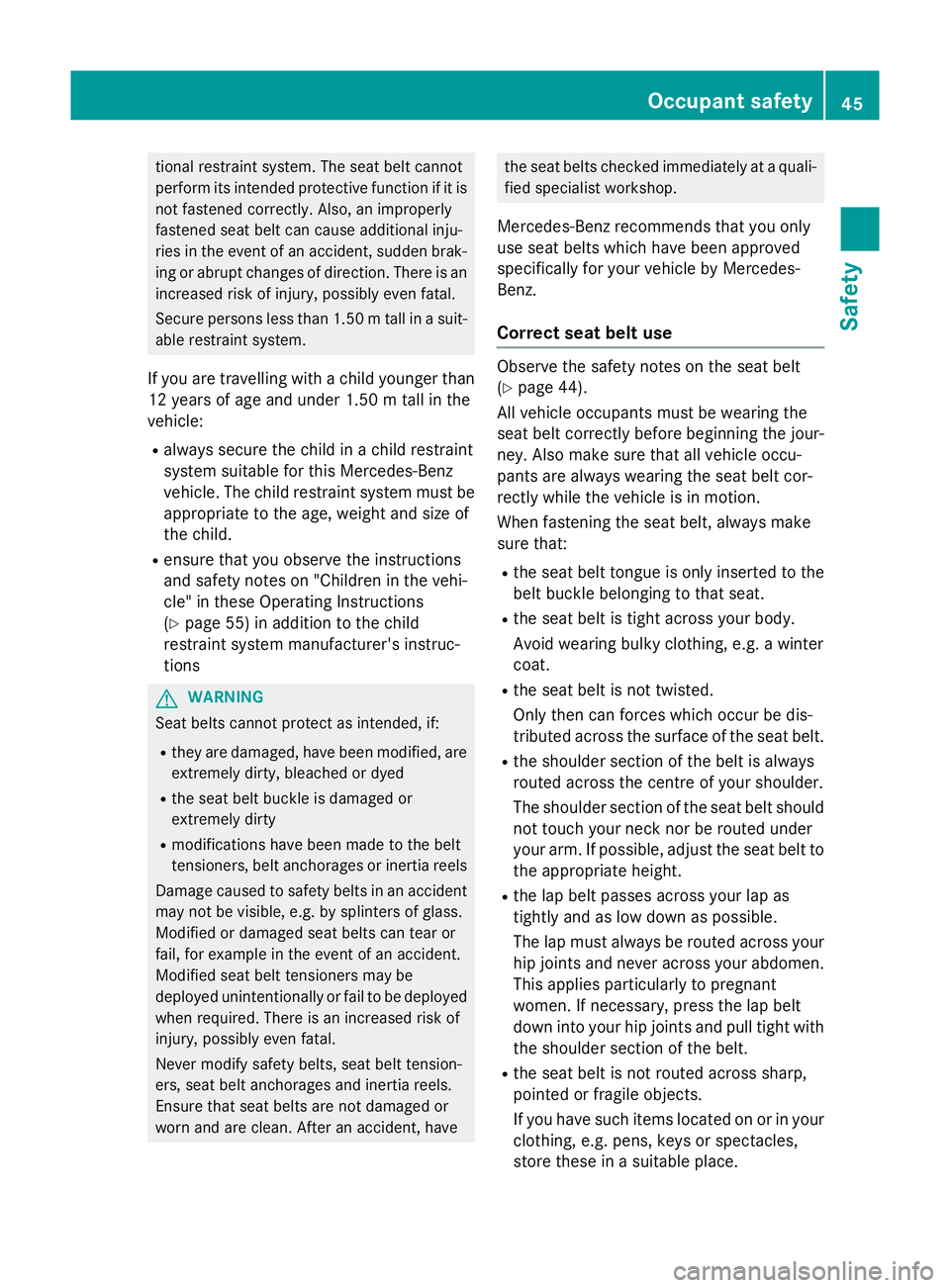
tional restraint system. The seat belt cannot
perform its intended protective function if it is not fastened correctly. Also, an improperly
fastened seat belt can cause additional inju-
ries in the event of an accident, sudden brak-
ing or abrupt changes of direction. There is an increased risk of injury, possibly even fatal.
Secure persons less than 1.50 mtall in a suit-
able restraint system.
If you are travelling with a child younger than
12 years of age and under 1.50 m tall in the
vehicle:
R always secure the child in a child restraint
system suitable for this Mercedes-Benz
vehicle. The child restraint system must be
appropriate to the age, weight and size of
the child.
R ensure that you observe the instructions
and safety notes on "Children in the vehi-
cle" in these Operating Instructions
(Y page 55) in addition to the child
restraint system manufacturer's instruc-
tions G
WARNING
Seat belts cannot protect as intended, if:
R they are damaged, have been modified, are
extremely dirty, bleached or dyed
R the seat belt buckle is damaged or
extremely dirty
R modifications have been made to the belt
tensioners, belt anchorages or inertia reels
Damage caused to safety belts in an accident may not be visible, e.g. by splinters of glass.
Modified or damaged seat belts can tear or
fail, for example in the event of an accident.
Modified seat belt tensioners may be
deployed unintentionally or fail to be deployed
when required. There is an increased risk of
injury, possibly even fatal.
Never modify safety belts, seat belt tension-
ers, seat belt anchorages and inertia reels.
Ensure that seat belts are not damaged or
worn and are clean. After an accident, have the seat belts checked immediately at a quali-
fied specialist workshop.
Mercedes-Benz recommends that you only
use seat belts which have been approved
specifically for your vehicle by Mercedes-
Benz.
Correct seat belt use Observe the safety notes on the seat belt
(Y
page 44).
All vehicle occupants must be wearing the
seat belt correctly before beginning the jour- ney. Also make sure that all vehicle occu-
pants are always wearing the seat belt cor-
rectly while the vehicle is in motion.
When fastening the seat belt, always make
sure that:
R the seat belt tongue is only inserted to the
belt buckle belonging to that seat.
R the seat belt is tight across your body.
Avoid wearing bulky clothing, e.g. a winter
coat.
R the seat belt is not twisted.
Only then can forces which occur be dis-
tributed across the surface of the seat belt.
R the shoulder section of the belt is always
routed across the centre of your shoulder.
The shoulder section of the seat belt should
not touch your neck nor be routed under
your arm. If possible, adjust the seat belt to the appropriate height.
R the lap belt passes across your lap as
tightly and as low down as possible.
The lap must always be routed across your
hip joints and never across your abdomen.This applies particularly to pregnant
women. If necessary, press the lap belt
down into your hip joints and pull tight withthe shoulder section of the belt.
R the seat belt is not routed across sharp,
pointed or fragile objects.
If you have such items located on or in your
clothing, e.g. pens, keys or spectacles,
store these in a suitable place. Occupant safety
45Safety Z
Page 49 of 417
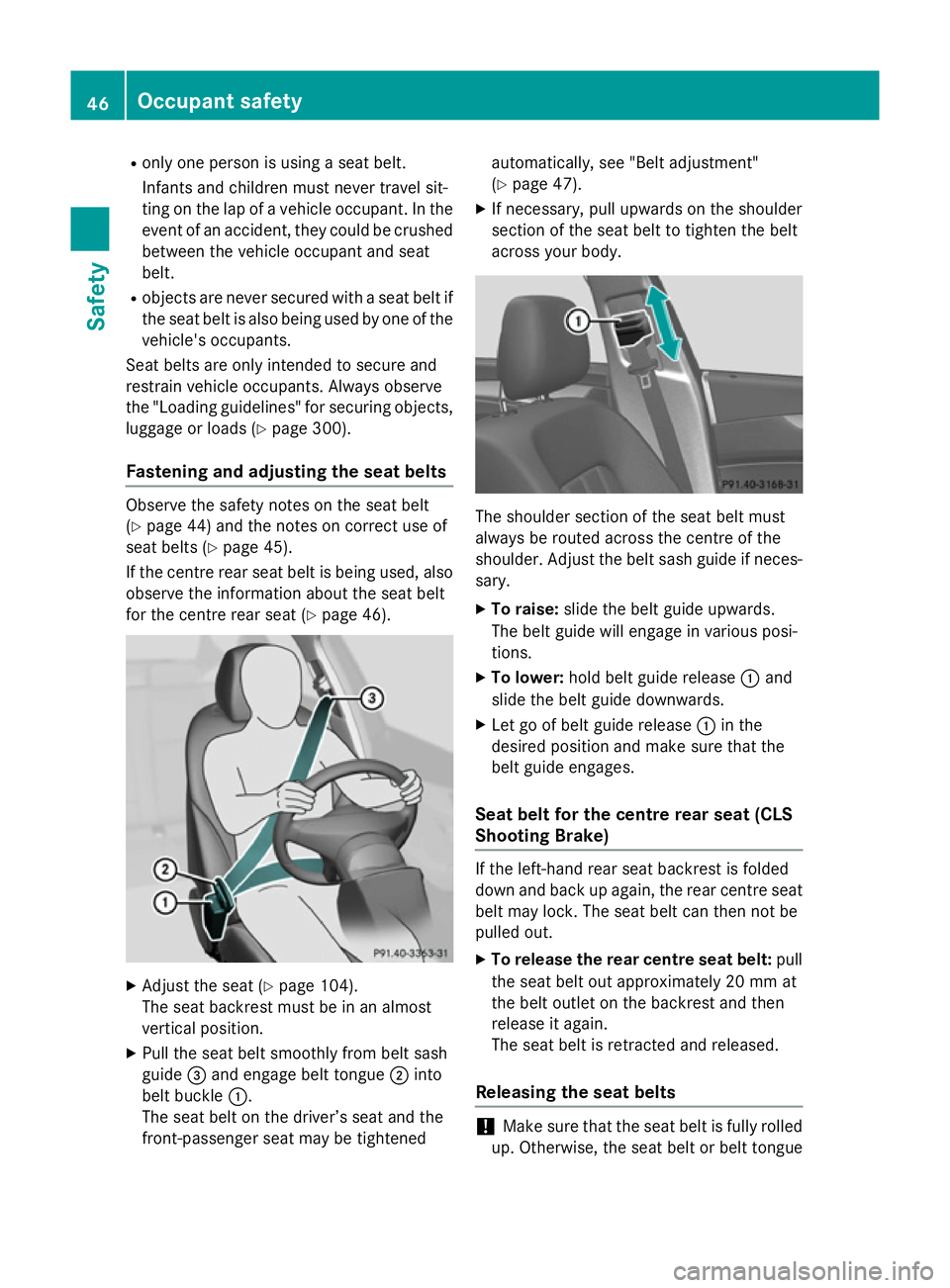
R
only one person is using a seat belt.
Infants and children must never travel sit-
ting on the lap of a vehicle occupant. In the
event of an accident, they could be crushed between the vehicle occupant and seat
belt.
R objects are never secured with a seat belt if
the seat belt is also being used by one of the vehicle's occupants.
Seat belts are only intended to secure and
restrain vehicle occupants. Always observe
the "Loading guidelines" for securing objects,
luggage or loads (Y page 300).
Fastening and adjusting the seat belts Observe the safety notes on the seat belt
(Y page 44) and the notes on correct use of
seat belts (Y page 45).
If the centre rear seat belt is being used, also
observe the information about the seat belt
for the centre rear seat (Y page 46).X
Adjust the seat (Y page 104).
The seat backrest must be in an almost
vertical position.
X Pull the seat belt smoothly from belt sash
guide =and engage belt tongue ;into
belt buckle :.
The seat belt on the driver’s seat and the
front-passenger seat may be tightened automatically, see "Belt adjustment"
(Y
page 47).
X If necessary, pull upwards on the shoulder
section of the seat belt to tighten the belt
across your body. The shoulder section of the seat belt must
always be routed across the centre of the
shoulder. Adjust the belt sash guide if neces-
sary.
X To raise: slide the belt guide upwards.
The belt guide will engage in various posi-
tions.
X To lower: hold belt guide release :and
slide the belt guide downwards.
X Let go of belt guide release :in the
desired position and make sure that the
belt guide engages.
Seat belt for the centre rear seat (CLS
Shooting Brake) If the left-hand rear seat backrest is folded
down and back up again, the rear centre seat
belt may lock. The seat belt can then not be
pulled out.
X To release the rear centre seat belt: pull
the seat belt out approximately 20 mm at
the belt outlet on the backrest and then
release it again.
The seat belt is retracted and released.
Releasing the seat belts !
Make sure that the seat belt is fully rolled
up. Otherwise, the seat belt or belt tongue 46
Occupant safetySafety
Page 50 of 417
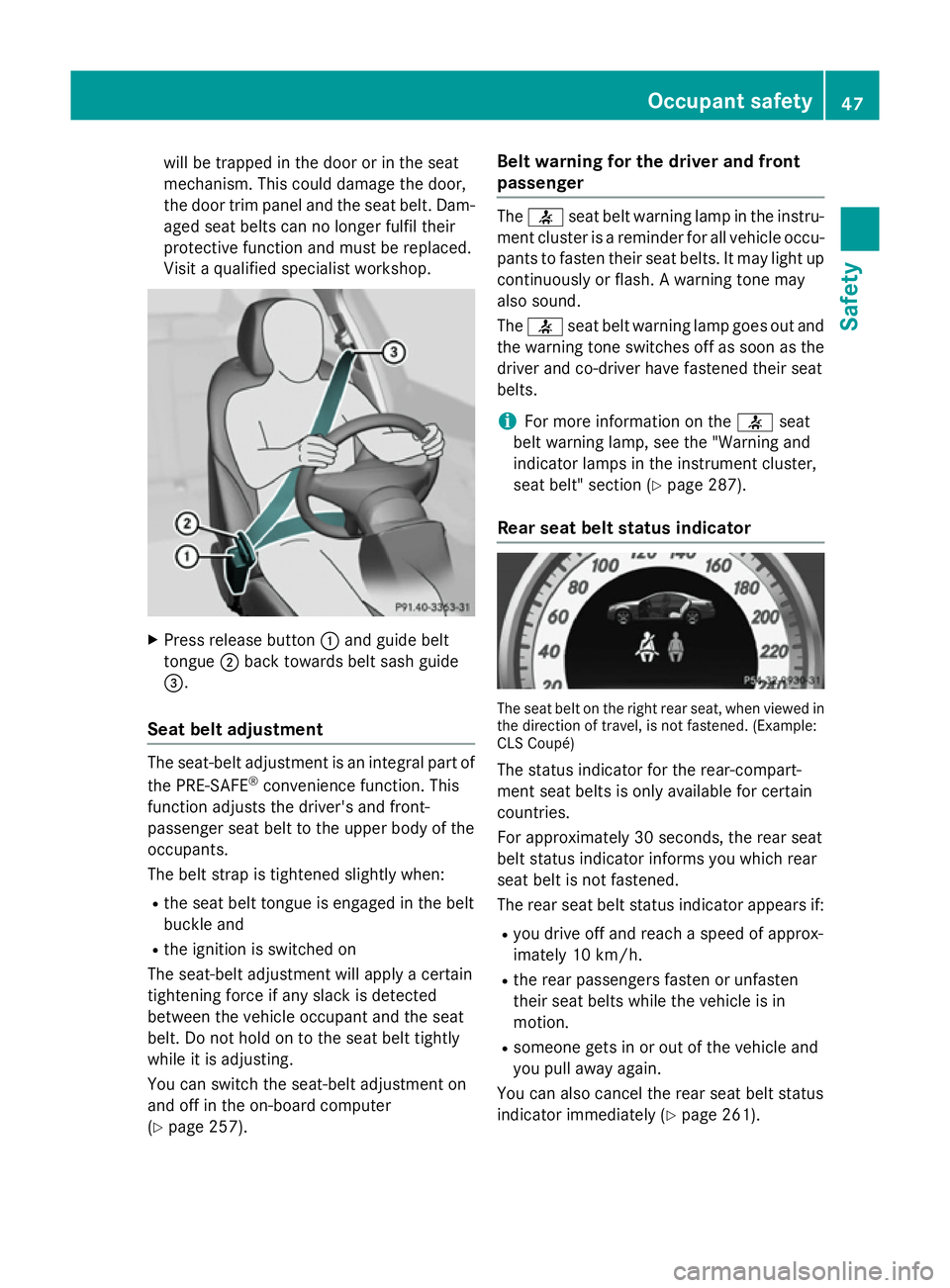
will be trapped in the door or in the seat
mechanism. This could damage the door,
the door trim panel and the seat belt. Dam- aged seat belts can no longer fulfil their
protective function and must be replaced.
Visit a qualified specialist workshop. X
Press release button :and guide belt
tongue ;back towards belt sash guide
=.
Seat belt adjustment The seat-belt adjustment is an integral part of
the PRE-SAFE ®
convenience function. This
function adjusts the driver's and front-
passenger seat belt to the upper body of the
occupants.
The belt strap is tightened slightly when:
R the seat belt tongue is engaged in the belt
buckle and
R the ignition is switched on
The seat-belt adjustment will apply a certain
tightening force if any slack is detected
between the vehicle occupant and the seat
belt. Do not hold on to the seat belt tightly
while it is adjusting.
You can switch the seat-belt adjustment on
and off in the on-board computer
(Y page 257). Belt warning for the driver and front
passenger The
7 seat belt warning lamp in the instru-
ment cluster is a reminder for all vehicle occu-
pants to fasten their seat belts. It may light up continuously or flash. A warning tone may
also sound.
The 7 seat belt warning lamp goes out and
the warning tone switches off as soon as the driver and co-driver have fastened their seat
belts.
i For more information on the
7seat
belt warning lamp, see the "Warning and
indicator lamps in the instrument cluster,
seat belt" section (Y page 287).
Rear seat belt status indicator The seat belt on the right rear seat, when viewed in
the direction of travel, is not fastened. (Example:
CLS Coupé)
The status indicator for the rear-compart-
ment seat belts is only available for certain
countries.
For approximately 30 seconds, the rear seat
belt status indicator informs you which rear
seat belt is not fastened.
The rear seat belt status indicator appears if:
R you drive off and reach a speed of approx-
imately 10 km/h.
R the rear passengers fasten or unfasten
their seat belts while the vehicle is in
motion.
R someone gets in or out of the vehicle and
you pull away again.
You can also cancel the rear seat belt status
indicator immediately (Y page 261). Occupant safety
47Safety Z
Page 51 of 417
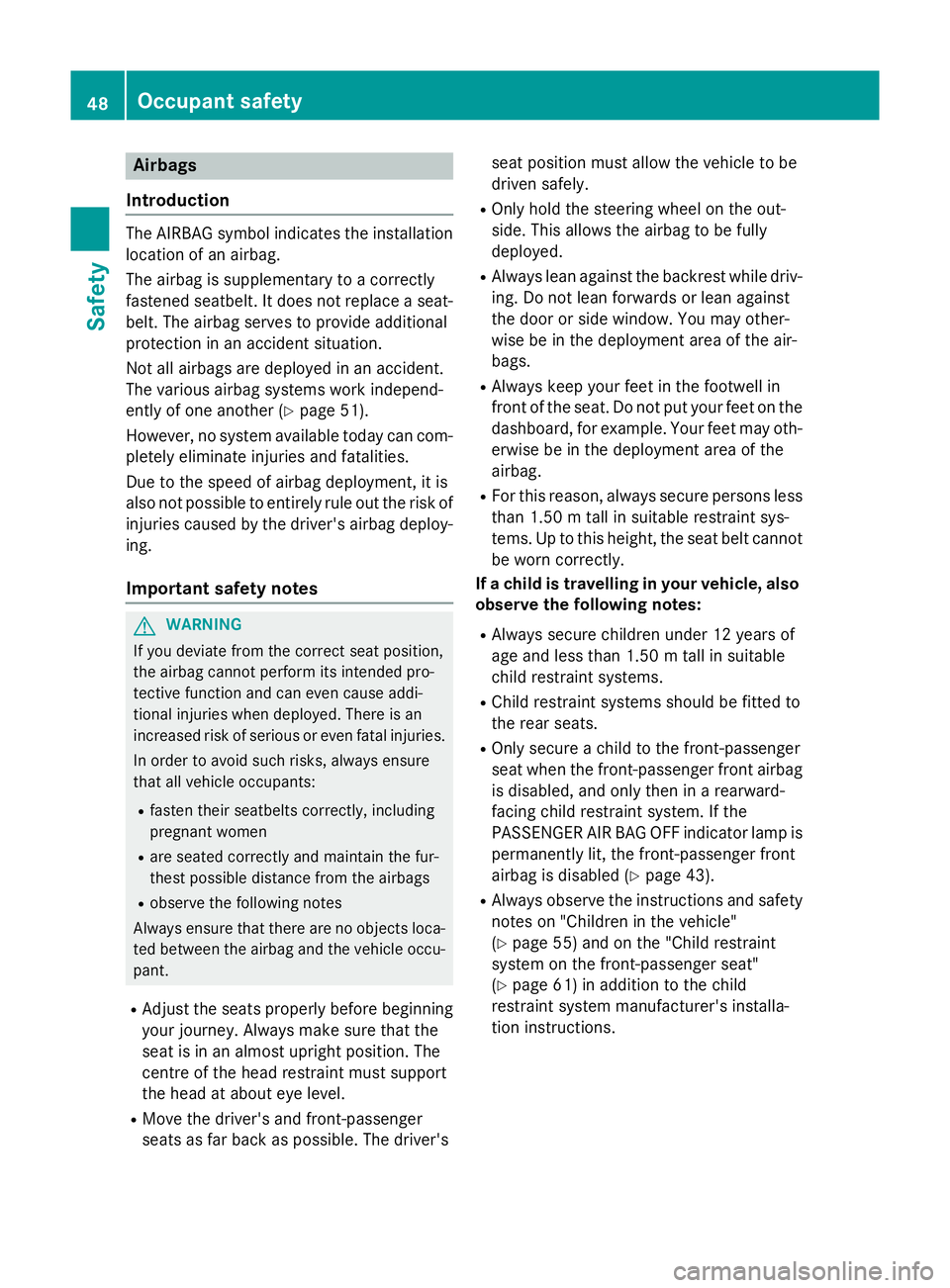
Airbags
Introduction The AIRBAG symbol indicates the installation
location of an airbag.
The airbag is supplementary to a correctly
fastened seatbelt. It does not replace a seat- belt. The airbag serves to provide additional
protection in an accident situation.
Not all airbags are deployed in an accident.
The various airbag systems work independ-
ently of one another (Y page 51).
However, no system available today can com- pletely eliminate injuries and fatalities.
Due to the speed of airbag deployment, it is
also not possible to entirely rule out the risk of
injuries caused by the driver's airbag deploy-
ing.
Important safety notes G
WARNING
If you deviate from the correct seat position,
the airbag cannot perform its intended pro-
tective function and can even cause addi-
tional injuries when deployed. There is an
increased risk of serious or even fatal injuries.
In order to avoid such risks, always ensure
that all vehicle occupants:
R fasten their seatbelts correctly, including
pregnant women
R are seated correctly and maintain the fur-
thest possible distance from the airbags
R observe the following notes
Always ensure that there are no objects loca-
ted between the airbag and the vehicle occu-
pant.
R Adjust the seats properly before beginning
your journey. Always make sure that the
seat is in an almost upright position. The
centre of the head restraint must support
the head at about eye level.
R Move the driver's and front-passenger
seats as far back as possible. The driver's seat position must allow the vehicle to be
driven safely.
R Only hold the steering wheel on the out-
side. This allows the airbag to be fully
deployed.
R Always lean against the backrest while driv-
ing. Do not lean forwards or lean against
the door or side window. You may other-
wise be in the deployment area of the air-
bags.
R Always keep your feet in the footwell in
front of the seat. Do not put your feet on the
dashboard, for example. Your feet may oth-
erwise be in the deployment area of the
airbag.
R For this reason, always secure persons less
than 1.50 mtall in suitable restraint sys-
tems. Up to this height, the seat belt cannot
be worn correctly.
If a child is travelling in your vehicle, also
observe the following notes:
R Always secure children under 12 years of
age and less than 1.50 mtall in suitable
child restraint systems.
R Child restraint systems should be fitted to
the rear seats.
R Only secure a child to the front-passenger
seat when the front-passenger front airbag
is disabled, and only then in a rearward-
facing child restraint system. If the
PASSENGER AIR BAG OFF indicator lamp is
permanently lit, the front-passenger front
airbag is disabled (Y page 43).
R Always observe the instructions and safety
notes on "Children in the vehicle"
(Y page 55) and on the "Child restraint
system on the front-passenger seat"
(Y page 61) in addition to the child
restraint system manufacturer's installa-
tion instructions. 48
Occupant safetySafety
Page 54 of 417
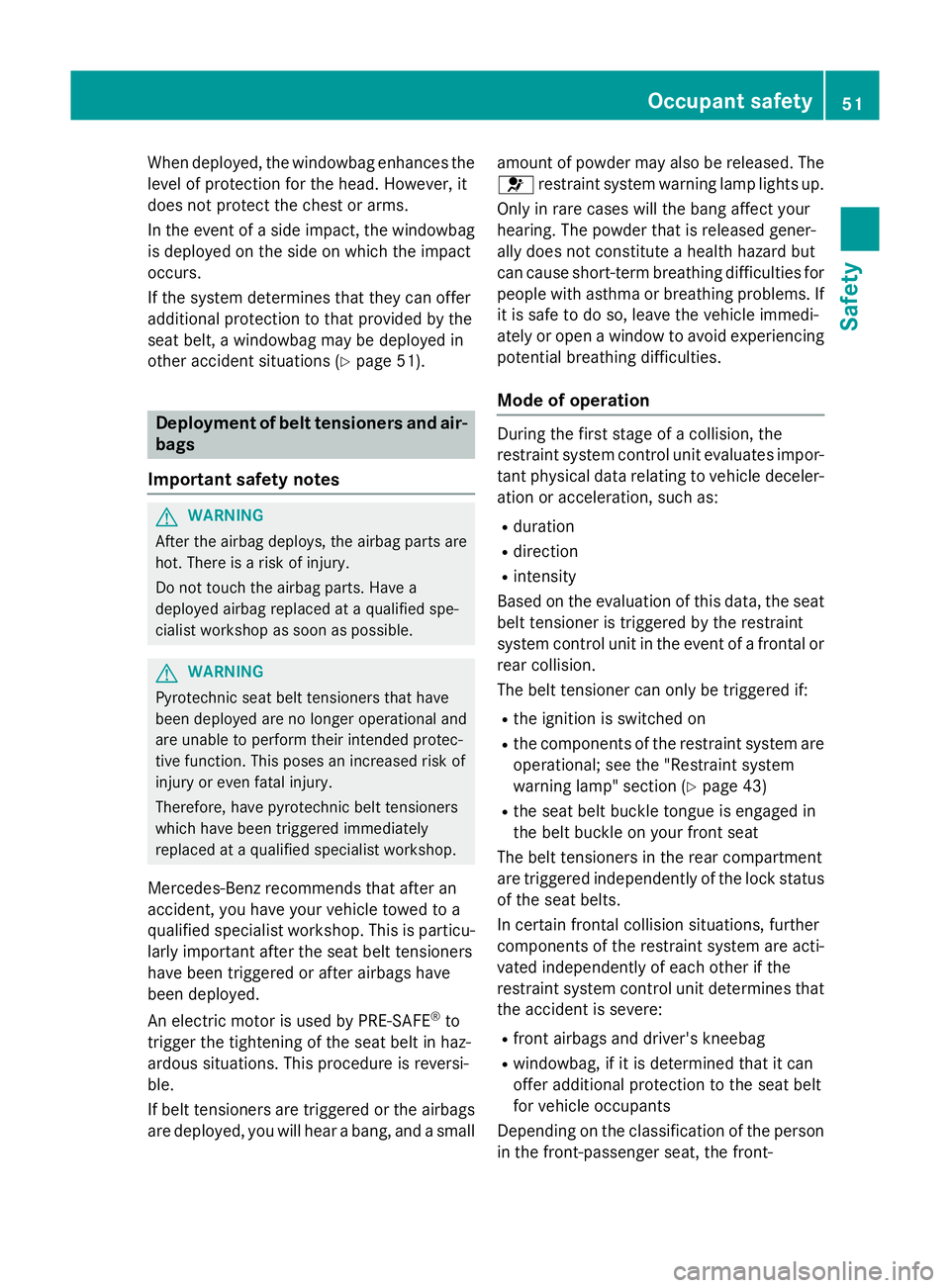
When deployed, the windowbag enhances the
level of protection for the head. However, it
does not protect the chest or arms.
In the event of a side impact, the windowbag
is deployed on the side on which the impact
occurs.
If the system determines that they can offer
additional protection to that provided by the
seat belt, a windowbag may be deployed in
other accident situations (Y page 51).Deployment of belt tensioners and air-
bags
Important safety notes G
WARNING
After the airbag deploys, the airbag parts are
hot. There is a risk of injury.
Do not touch the airbag parts. Have a
deployed airbag replaced at a qualified spe-
cialist workshop as soon as possible. G
WARNING
Pyrotechnic seat belt tensioners that have
been deployed are no longer operational and
are unable to perform their intended protec-
tive function. This poses an increased risk of
injury or even fatal injury.
Therefore, have pyrotechnic belt tensioners
which have been triggered immediately
replaced at a qualified specialist workshop.
Mercedes-Benz recommends that after an
accident, you have your vehicle towed to a
qualified specialist workshop. This is particu- larly important after the seat belt tensioners
have been triggered or after airbags have
been deployed.
An electric motor is used by PRE-SAFE ®
to
trigger the tightening of the seat belt in haz-
ardous situations. This procedure is reversi-
ble.
If belt tensioners are triggered or the airbags
are deployed, you will hear a bang, and a small amount of powder may also be released. The
6 restraint system warning lamp lights up.
Only in rare cases will the bang affect your
hearing. The powder that is released gener-
ally does not constitute a health hazard but
can cause short-term breathing difficulties for people with asthma or breathing problems. If
it is safe to do so, leave the vehicle immedi-
ately or open a window to avoid experiencing potential breathing difficulties.
Mode of operation During the first stage of a collision, the
restraint system control unit evaluates impor-
tant physical data relating to vehicle deceler- ation or acceleration, such as:
R duration
R direction
R intensity
Based on the evaluation of this data, the seat belt tensioner is triggered by the restraint
system control unit in the event of a frontal or
rear collision.
The belt tensioner can only be triggered if:
R the ignition is switched on
R the components of the restraint system are
operational; see the "Restraint system
warning lamp" section (Y page 43)
R the seat belt buckle tongue is engaged in
the belt buckle on your front seat
The belt tensioners in the rear compartment
are triggered independently of the lock status of the seat belts.
In certain frontal collision situations, further
components of the restraint system are acti-
vated independently of each other if the
restraint system control unit determines that the accident is severe:
R front airbags and driver's kneebag
R windowbag, if it is determined that it can
offer additional protection to the seat belt
for vehicle occupants
Depending on the classification of the person in the front-passenger seat, the front- Occupant safety
51Safety Z
Page 55 of 417
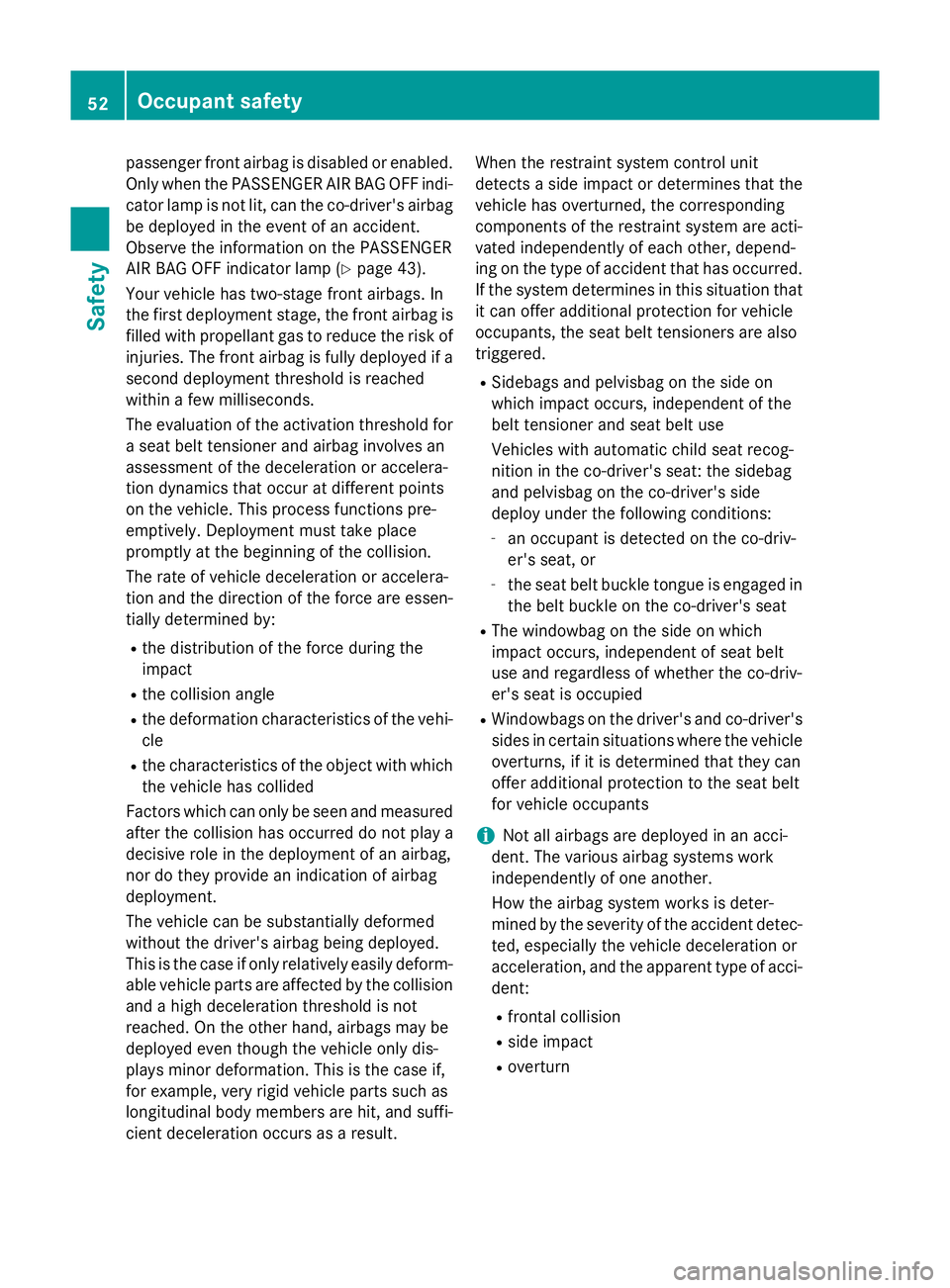
passenger front airbag is disabled or enabled.
Only when the PASSENGER AIR BAG OFF indi-cator lamp is not lit, can the co-driver's airbag
be deployed in the event of an accident.
Observe the information on the PASSENGER
AIR BAG OFF indicator lamp (Y page 43).
Your vehicle has two-stage front airbags. In
the first deployment stage, the front airbag is filled with propellant gas to reduce the risk of
injuries. The front airbag is fully deployed if a second deployment threshold is reached
within a few milliseconds.
The evaluation of the activation threshold for
a seat belt tensioner and airbag involves an
assessment of the deceleration or accelera-
tion dynamics that occur at different points
on the vehicle. This process functions pre-
emptively. Deployment must take place
promptly at the beginning of the collision.
The rate of vehicle deceleration or accelera-
tion and the direction of the force are essen- tially determined by:
R the distribution of the force during the
impact
R the collision angle
R the deformation characteristics of the vehi-
cle
R the characteristics of the object with which
the vehicle has collided
Factors which can only be seen and measured after the collision has occurred do not play a
decisive role in the deployment of an airbag,
nor do they provide an indication of airbag
deployment.
The vehicle can be substantially deformed
without the driver's airbag being deployed.
This is the case if only relatively easily deform-
able vehicle parts are affected by the collision
and a high deceleration threshold is not
reached. On the other hand, airbags may be
deployed even though the vehicle only dis-
plays minor deformation. This is the case if,
for example, very rigid vehicle parts such as
longitudinal body members are hit, and suffi-
cient deceleration occurs as a result. When the restraint system control unit
detects a side impact or determines that the
vehicle has overturned, the corresponding
components of the restraint system are acti-
vated independently of each other, depend-
ing on the type of accident that has occurred.
If the system determines in this situation that
it can offer additional protection for vehicle
occupants, the seat belt tensioners are also
triggered.
R Sidebags and pelvisbag on the side on
which impact occurs, independent of the
belt tensioner and seat belt use
Vehicles with automatic child seat recog-
nition in the co-driver's seat: the sidebag
and pelvisbag on the co-driver's side
deploy under the following conditions:
- an occupant is detected on the co-driv-
er's seat, or
- the seat belt buckle tongue is engaged in
the belt buckle on the co-driver's seat
R The windowbag on the side on which
impact occurs, independent of seat belt
use and regardless of whether the co-driv-
er's seat is occupied
R Windowbags on the driver's and co-driver's
sides in certain situations where the vehicle
overturns, if it is determined that they can
offer additional protection to the seat belt
for vehicle occupants
i Not all airbags are deployed in an acci-
dent. The various airbag systems work
independently of one another.
How the airbag system works is deter-
mined by the severity of the accident detec- ted, especially the vehicle deceleration or
acceleration, and the apparent type of acci- dent:
R frontal collision
R side impact
R overturn 52
Occupant safetySafety